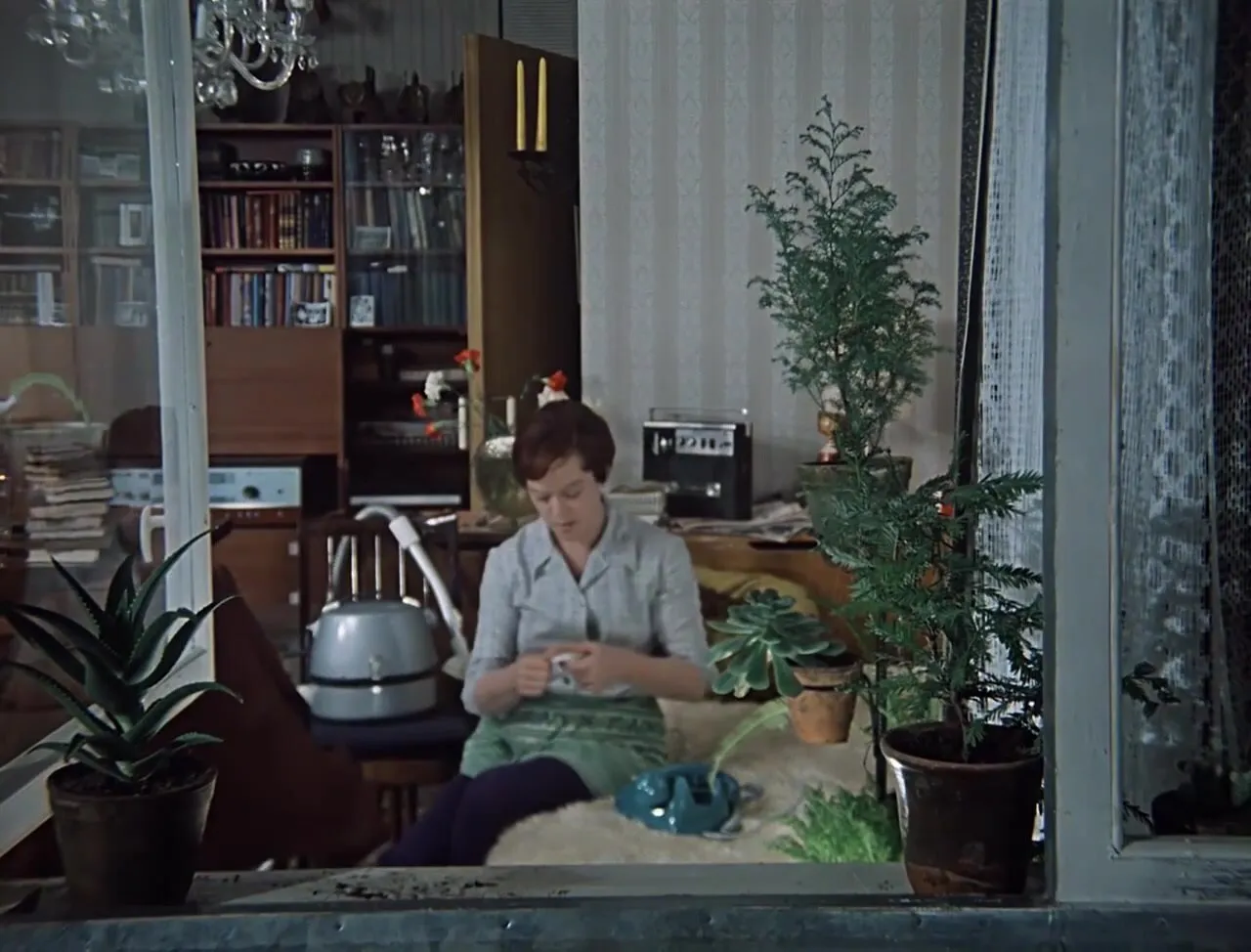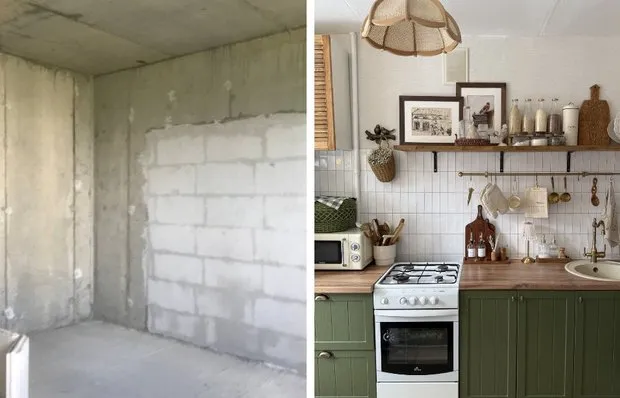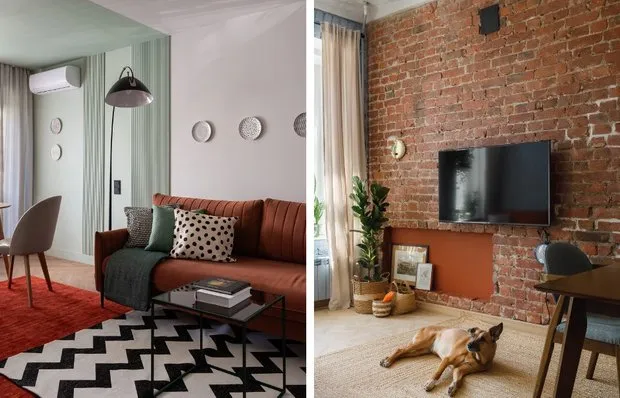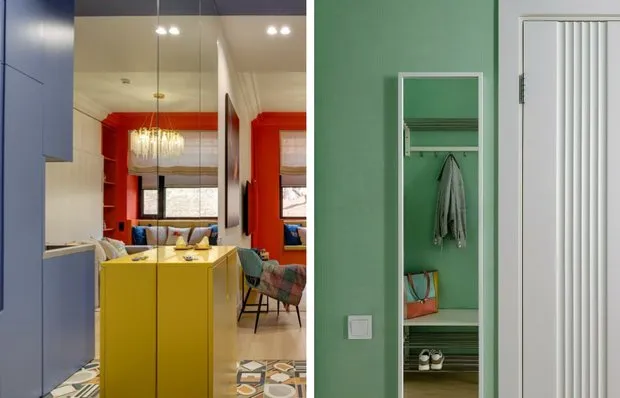There can be your advertisement
300x150
How Apartments Were Decorated in Soviet Films: From 'Irony of Fate' to 'Service Romance'
Each wall told about the hero's status, and each vase hinted at his income
"Such furniture, bought in Mостorg, 25 rubles extra!" — Nadia complained in 'Irony of Fate.' And she was right: Soviet cinema showed exactly the furniture that was in real apartments. Yugoslav wardrobes, Czech tableware, Romanian armchairs — all of it was the pinnacle of dreams for an ordinary family.
Art directors turned scarce furniture into screen stars. Each wardrobe told about the hero's status, and each vase hinted at his income. Audiences studied the interiors no less carefully than fashion magazines, remembering how a real beautiful life looked.
Main points from the article:
- Decorations for 'Irony of Fate' were created in the Mosfilm pavilion, but using actual furniture from that time;
- The Yugoslav wardrobe was a symbol of prosperity — its cost equaled 2-3 salaries of an engineer;
- Interiors in 'Service Romance' were created by artists Alexander Borisov and Sergey Voronkov — masters of timeless design;
- Samokhvalov lived in an apartment packed with trendy novelties — from velvet armchairs to pseudo-lamps;
- Furniture for filming was often "obtained through connections" — real scarce Yugoslav 'Manuela' or Romanian 'Roxana'.
"What a nuisance this fish sauce is": Interior as a character
In 'Irony of Fate,' the essence of the plot lies in the uniformity of Soviet life. "Standard sets. Whether in Moscow or Leningrad," — explained Ippolit. And the art director Alexander Borisov brilliantly embodied this idea.
Jenya and Nadia's apartments were shot in the same pavilion decoration, only with different furniture arrangements. The Yugoslav wardrobe, a checkered blanket, a guitar in the corner — typical elements of a successful Soviet intellectual. 'Klim' on the table, a photo of Ippolit in the wardrobe — every detail worked for recognition.
Master Galina Yumashova, who recreated the film's decor in miniature, reviewed the picture countless times: "The 'Klim' spirits released in 1975 greatly differ in packaging design from later versions." There it is — Soviet perfectionism!
 Frame from the film "Irony of Fate, or With a Light Breeze!"
Frame from the film "Irony of Fate, or With a Light Breeze!"Yugoslav Wardrobe: When Furniture Was Currency
"If you get a coupon for a Yugoslav wardrobe — that's happiness," — recall contemporaries. The wardrobe was at the top of the hierarchy of prestigious items, on par with a carpet and a car. It cost as much as 2-3 engineer salaries, and waiting in line could take months.
Yugoslav wardrobes had beautiful names: 'Manuela', 'Rogers', 'Julia'. People knew every model by face, although they weren't sold in stores. The quality was fantastic — made from solid wood, hardware from real steel.
In films, the wardrobe was instantly recognized as a sign of prosperity. Showing a Yugoslav 'Manuela' meant the hero had succeeded in life. A Romanian 'Roxana' was also fine. A Soviet fake already indicated more modest wealth.
'Service Romance': When Old Meets Modern
In 'Service Romance,' the art directors Alexander Borisov and Sergey Voronkov created interiors that still look stylish today. The secret is in bold combinations of old elements with modern furniture.
The statistical institution was located in a 1900-built house. Ornate cast-iron railings, intricate brackets, bronze chandeliers — and next to them, modern lamps made of milk glass. Nothing clashed the eyes!
"60% of the interior was a complex gray-blue color," — designers note. This technique is still used in modern offices today. Borisov and Voronkov were ahead of their time by thirty years.
 Frame from the film "Service Romance"
Frame from the film "Service Romance"Samokhvalov's Apartment: When Too Much Is Just Right
For the deputy director, a stylish home full of novelties to impress friends and important people. Closed shelves in a ladder style (then it was the height of fashion), velvet armchairs, flowered curtains — all the most prestigious.
A genius shot: the reflection of a lampshade in a mirror with a heavy frame, pseudo-lamps. "A perfect combination of Samokhvalov's bourgeois essence with a longing for fashionable, Western, prestigious styles," — note film scholars.
As for Kalugina, everything was strict and modest — no excesses. The entire apartment immediately made it clear: we're looking at a principled woman who doesn't chase trends. The interior as a psychological portrait.
 Frame from the film "Service Romance"
Frame from the film "Service Romance"Furniture on Rent: How They Got Props
Real scarce furniture for filming had to be "obtained through connections." A Yugoslav wardrobe could be borrowed from acquaintances in the nomenclature. Czech crystal tableware — also scarce, which was guarded more carefully than eyes.
The art director Alexander Borisov managed to gather a huge amount of office supplies for 'Service Romance': typewriters, phones, hole punches. In the era of scarcity, this was a feat.
Often furniture was taken from the 'Mosfilm' archives — there were real treasures stored. Antique secretaries, pre-war buffets, foreign armchairs. All of it accumulated over the years at the studio.
The Color Palette of Soviet Prestige
Polished dark furniture in walnut color was the standard of luxury. Yugoslav wardrobes, Romanian sideboards, Czech chests — all in a unified style. Glossy lacquer, glass shelves, mirrored doors.
Textiles also had their rules: checkered blankets, flowered curtains, a mandatory carpet on the wall. In 'Irony of Fate,' the carpet was not just decoration — it insulated walls and improved soundproofing.
Crystal in the sideboard, porcelain figurines on shelves — every detail was worth its weight in gold. Showing a Czech tableware in frame meant emphasizing the hero's high status.
The Evolution of Soviet Interiors in Cinema
From the ascetic atmosphere of the 1950s to relative abundance in the 1970s — cinema captured changes in everyday life. In early films, there was almost no furniture, but later on, wardrobes and tableware appeared.
It's interesting that the most stylish interiors were created not from wealth, but from the taste of art directors. Borisov and Voronkov knew how to create a memorable atmosphere from a modest set of items.
Modern designers still study Soviet films as textbooks. The principle "less is more," combining old and new, functionality of every detail — all this comes from the pavilions of 'Mosfilm'.
Soviet interiors in cinema are not just beautiful images. They are an encyclopedia of dreams of an entire era, when the Yugoslav wardrobe was the pinnacle of desires, and real crystal was a symbol of wealth.
Cover from the website: lifehacker.ru
More articles:
 Kitchen 6 sq m for 100 thousand: how to make it stylish and functional
Kitchen 6 sq m for 100 thousand: how to make it stylish and functional Five Tricks That Visually Expand Your Kitchen Without Demolishing Walls
Five Tricks That Visually Expand Your Kitchen Without Demolishing Walls Repair Without Headache: 7 Modern Tips to Plan Everything and Not Forget Anything
Repair Without Headache: 7 Modern Tips to Plan Everything and Not Forget Anything Zinger House: Where Valkyries Guard Secrets of Durov and the Globe Has Been Lit for 120 Years
Zinger House: Where Valkyries Guard Secrets of Durov and the Globe Has Been Lit for 120 Years The Secret Designer Trick That Visually Expands Any Room
The Secret Designer Trick That Visually Expands Any Room How to Create an Accent Wall in the Living Room: 6 Ideas
How to Create an Accent Wall in the Living Room: 6 Ideas Ring Houses: How Circular Apartments Emerged in Moscow
Ring Houses: How Circular Apartments Emerged in Moscow Color — the Key to Impression: 5 Small Entrances That Captivate at First Glance
Color — the Key to Impression: 5 Small Entrances That Captivate at First Glance